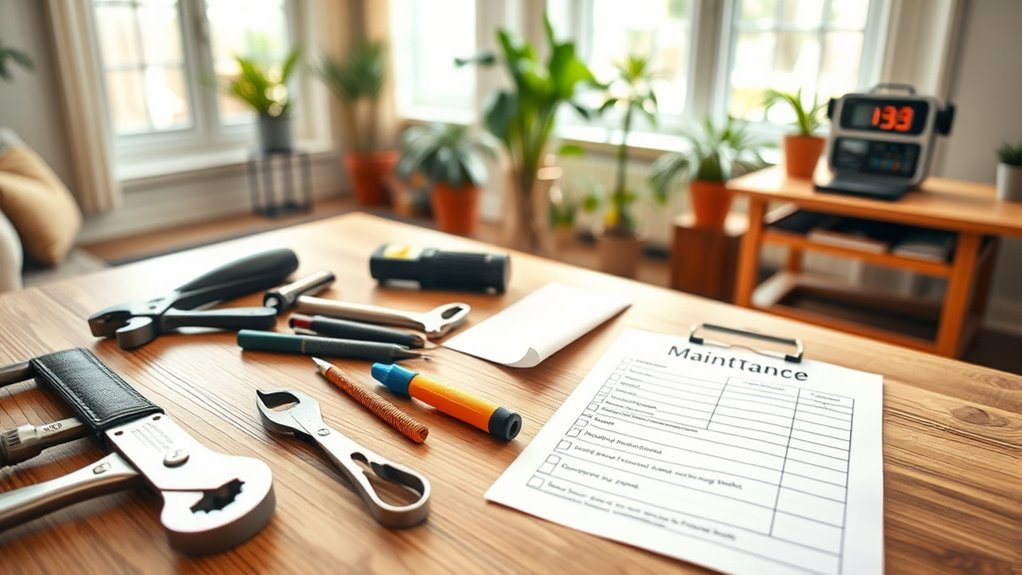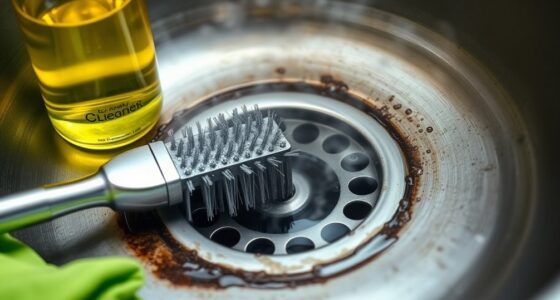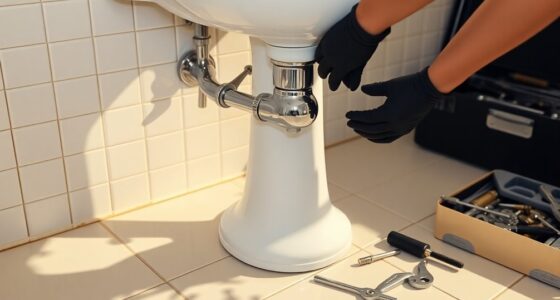To keep your home in top shape, tackle monthly tasks like replacing HVAC filters, inspecting for leaks, clearing gutters, and testing detectors. Seasonal chores include sealing cracks in spring, inspecting your roof in summer, sealing drafts in fall, and insulating pipes during winter. Staying on top of these tasks prevents costly repairs and ensures your home remains safe and efficient year-round. Keep going to discover a detailed checklist to guide you through each season.
Key Takeaways
- Perform monthly tasks like replacing HVAC filters, inspecting plumbing, and testing smoke detectors.
- Conduct seasonal maintenance in spring, such as sealing cracks, inspecting the roof, and cleaning gutters.
- Carry out summer chores like outdoor upgrades, garden care, and outdoor furniture maintenance.
- Prepare for fall with heating inspections, chimney cleaning, sealing drafts, and insulating pipes.
- In winter, focus on insulating pipes, sealing drafts, inspecting ventilation, and maintaining indoor systems.

Keeping up with home maintenance might seem overwhelming, but staying on top of regular tasks can save you time and money in the long run. When you handle routine chores consistently, you prevent small issues from becoming costly repairs. Start by creating a manageable schedule that covers both monthly and yearly tasks. This proactive approach ensures your home remains in good condition and reduces emergency repairs. For monthly maintenance, focus on simple tasks that keep everything running smoothly. Check your HVAC filters and replace them if they’re dirty—that’s a quick way to improve air quality and efficiency. Inspect your plumbing for leaks or drips, especially under sinks and around toilets. Catching leaks early prevents water waste and potential damage. Clear gutters and downspouts of debris to ensure proper drainage, especially after storms or heavy rain. If you notice any minor repairs needed, like a loose cabinet handle or a flickering light, tackle those as DIY repairs. Fixing small issues yourself saves money and keeps your home functioning well. Also, test your smoke and carbon monoxide detectors monthly to ensure they’re working properly—safety always comes first.
Seasonal upgrades are another essential part of your maintenance routine. As seasons change, so do your home’s needs. In spring, consider sealing cracks around windows and doors to improve insulation and prevent drafts. Clean and inspect your roof for any damage after winter, repairing or replacing shingles as necessary. Summer is a great time to upgrade outdoor spaces—think about repainting fences, planting new landscaping, or installing a new sprinkler system. These seasonal upgrades boost your home’s curb appeal and functionality. In fall, prepare your heating system for winter by scheduling a professional inspection or replacing filters. Clean out your chimney if you have a fireplace, and store summer outdoor furniture. Winter calls for protecting your home against the cold—insulate pipes to prevent freezing, and check for drafts around windows and doors, sealing gaps with weatherstripping or caulking. Regularly inspecting your home’s projector setup can also help ensure your entertainment systems operate smoothly, especially if you use your home theater frequently. Additionally, considering air quality improvements, like using air purifiers, can contribute to healthier indoor environments during seasonal transitions. Being aware of organic and natural juices can inspire you to incorporate healthier beverages into your routine as part of your overall wellness and home lifestyle. Regular maintenance of your home’s ventilation systems can also improve indoor air quality and energy efficiency, making your home more comfortable year-round.
Frequently Asked Questions
How Do I Prioritize Home Maintenance Tasks Effectively?
When it comes to maintenance scheduling, you should start by identifying the most urgent tasks that prevent damage or safety hazards. Use task prioritization to determine what needs immediate attention versus what can wait. Break your tasks into daily, weekly, and monthly categories, and tackle high-priority issues first. This approach guarantees your home stays safe and well-maintained without feeling overwhelmed, making your maintenance routine more effective and manageable.
What DIY Tools Are Essential for Home Upkeep?
When choosing DIY tools for home upkeep, focus on essential items like a screwdriver set, pliers, a hammer, and a wrench. Prioritize DIY safety by wearing protective gear and following instructions. Keep your tools organized in a toolbox to save time and prevent accidents. Regularly check and maintain your tools to guarantee they’re in good shape. These basics will help you tackle most maintenance tasks confidently and safely.
When Should I Hire a Professional for Repairs?
You should hire a professional when issues like seasonal pest control or appliance troubleshooting become complex or unsafe to handle alone. If you’ve tried basic fixes and still face problems, it’s time to call in experts. Professionals ensure thorough, safe repairs and can identify underlying issues. Don’t risk further damage or safety concerns—trust a specialist when repairs are beyond your DIY skills, especially for pest control or complex appliance repairs.
How Can I Detect Hidden Roof Leaks Early?
Think of hidden roof leaks as a silent threat lurking beneath the surface. Regular roof inspections help you spot issues early, especially around vulnerable areas like chimneys or vents. Pay attention to signs like water stains or mold, and use moisture detection tools to catch hidden leaks before they escalate. Acting promptly guarantees you catch problems early—don’t wait until it’s too late to prevent costly repairs down the line.
What Eco-Friendly Products Are Best for Home Maintenance?
When choosing eco-friendly products for home maintenance, you should look for sustainable cleaning options that are safe for the environment and your family. Opt for eco-friendly paints with low or zero volatile organic compounds (VOCs) to reduce indoor air pollution. These products not only protect the planet but also improve your home’s air quality, making your space healthier and more sustainable. Always read labels to guarantee you’re selecting genuinely eco-conscious products.
Conclusion
Staying on top of your home maintenance can save you thousands in repairs and keep your family safe. Did you know that neglecting regular upkeep can decrease your home’s value by up to 10%? By sticking to a monthly and yearly checklist, you ensure your home stays in top shape, preventing costly issues before they start. Take action today—your home’s future depends on the care you give it now.









